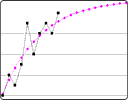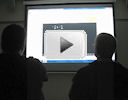IntMath Newsletter: Math tools, puzzles, poem
By Murray Bourne, 24 Jul 2012
24 Jul 2012
In this Newsletter:
1. Resources - Sketchometry and FluidMath
2. Teaching math with music
3. IntMath polls
4. Math puzzles
5. Friday math movies
6. Final thought - learning to learn
1. Resources
Here are 2 interesting new math software tools. The first comes at zero cost, while the second is a commercial product.
(a) Sketchometry - geometry tool for tablets (and PCs)
 |
Sketchometry is an interesting new gesture-based geometry tool. Here's my introduction: |
(b) FluidMath
Typing math into computers is normally a drag.
FluidMath is another tool with great potential for learning math. It allows the user to input math via handwriting and you can create interactive graphs, tables of data, and solve problems with its built-in algebra solver. There's great power in this approach.
It's primarily designed for Windows tablet PCs and interactive whiteboards. There are Mac and iPad versions on the way.
FluidMath appears to be well thought out and would double up as both a learning and teaching tool.
See a demonstration in a TED talk here: (Math comes to life). FluidMath is a commercial version of that project.
2. Teaching math with music
This Science Daily article describes how children learned fractions more effectively via an "Academic Music" curriculum that "uses music notation, clapping, drumming and chanting to introduce third-grade students to fractions".
Very few math classes for teenagers or university students involve music and I think that's a shame. Music can help trigger an emotional connection, and of course that can lead to better learning. Music is very important in the lives of teenagers - we should make more use of it to improve learning outcomes (and make math class more interesting!).
I've included some mentions of music throughout IntMath, for example Frequencies of Music Notes and Fast Fourier Transform. There was also the article on Music and Transformation Geometry.
3. IntMath polls
On a related note, the latest IntMath Poll asked readers about their music preferences when doing math. The highest response for "no music" weakens the stereotype that students love to have countless noise sources when doing homework.
The question was: When studying math, I like to listen to...
No music: 39%
Easy listening: 19%
Classical music: 18%
Loud music: 14%
Rap: 10%
Total votes: 1800.
It's interesting that around 3/4 of respondents either liked "no music" or relaxing music.
Actually, I used to like listening to music when doing homework in my student days, but not when learning for a test, for which I needed total quiet.
Current poll: The latest question asks readers about their gadget use when learning math. You can respond on any page in IntMath.
4. Math puzzles
(a) Last puzzle
The puzzle in the last Newsletter asked about the number of pages in a book. There were many responses - great!
Correct answers were given by Sanathanan, Thomas, Francis, Michael and Joseph (who all showed their reasoning). Tomas' correct answers were obtained in an interesting way. He used the Mahematica functional programming approach. Ardra also had correct answers.
(b) New puzzle #1
Anthony beat Bob in a set of tennis, winning 6 games to Bob's 3. Five games were won by the player who did not serve. Who served first?
Please respond to this puzzle here.
(c) New puzzle #2
The following puzzle is quite challenging. Have a think about it and see if you can crack it. (Please respond to this challenge puzzle here.)
 |
Can you fit a curve to given data with this constraint? |
4. Math poem
I received a delightful math poem as a response to a recent IntMath Newsletter, and I'm reproducing it here with the author's permission.
The poem is about the great mathematician Fibonacci, who tried to convince Europe about the superiority of the Hindu-Arabic number system (1, 2, 3, ...) in the 13th century.
Math Text Best-seller
Leonardo of Pisa in twelve-O-two
did something grand
few others could do.He wrote about math,
from east and from west
and made it quite clear to those who were stressed
doing transactions on fingers and toes
that methods in math could soon fix their woes.Buyers and sellers and children though small
could finally use math to answer the call
to buy and to sell; crunch numbers with ease
think algebraically; calculate fees.Without Fibonacci, as he later was called,
our world built on numbers would surely have stalled.
Janine Schaub Poetry, September 2011
Thank you, Janine, and keep writing your delightful poems!
5. Friday math movie: Two teachers learn math from Khan Academy
 |
Two math teachers mock as they watch a Khan Academy video. Are their criticisms fair, do you think? Friday math movie: Two teachers learn math from Khan Academy |
6. Final thought - learning to learn
This is from the authors of Freedom to Learn :
The only person who is educated is the one who has learned how to learn and change. [Carl Rogers and Jerome Freiberg]
Until next time, enjoy whatever you learn.
See the 2 Comments below.
31 Jul 2012 at 6:07 am [Comment permalink]
A serves and wins : X
A serves and loses: Y
B serves and wins : W
B serves and loses: Z
Then:
X+Z=6
Y+W=3
Y+Z=5
This gives us 4 solutions:
Y=0;X=1;W=3;Z=5
Y=1;X=2;W=2;Z=4
Y=2;X=3;W=1;Z=3
Y=3;X=4;W=0;Z=2
If A starts to serve: X+Y=5 else X+Y=4
X+Y=4 does not occur
X+Y=5 is the 3th solution
So Anthony was the first to serve
4 Sep 2012 at 8:31 am [Comment permalink]
9 games were played. 5 breaks occurred.
A serves -Broken
B serves -win
A serves -broken Fits criteria.
B serves -broken No need for math.
A serves -wins
B serves -broken
A serves -wins
B serves -broken
A serves -wins